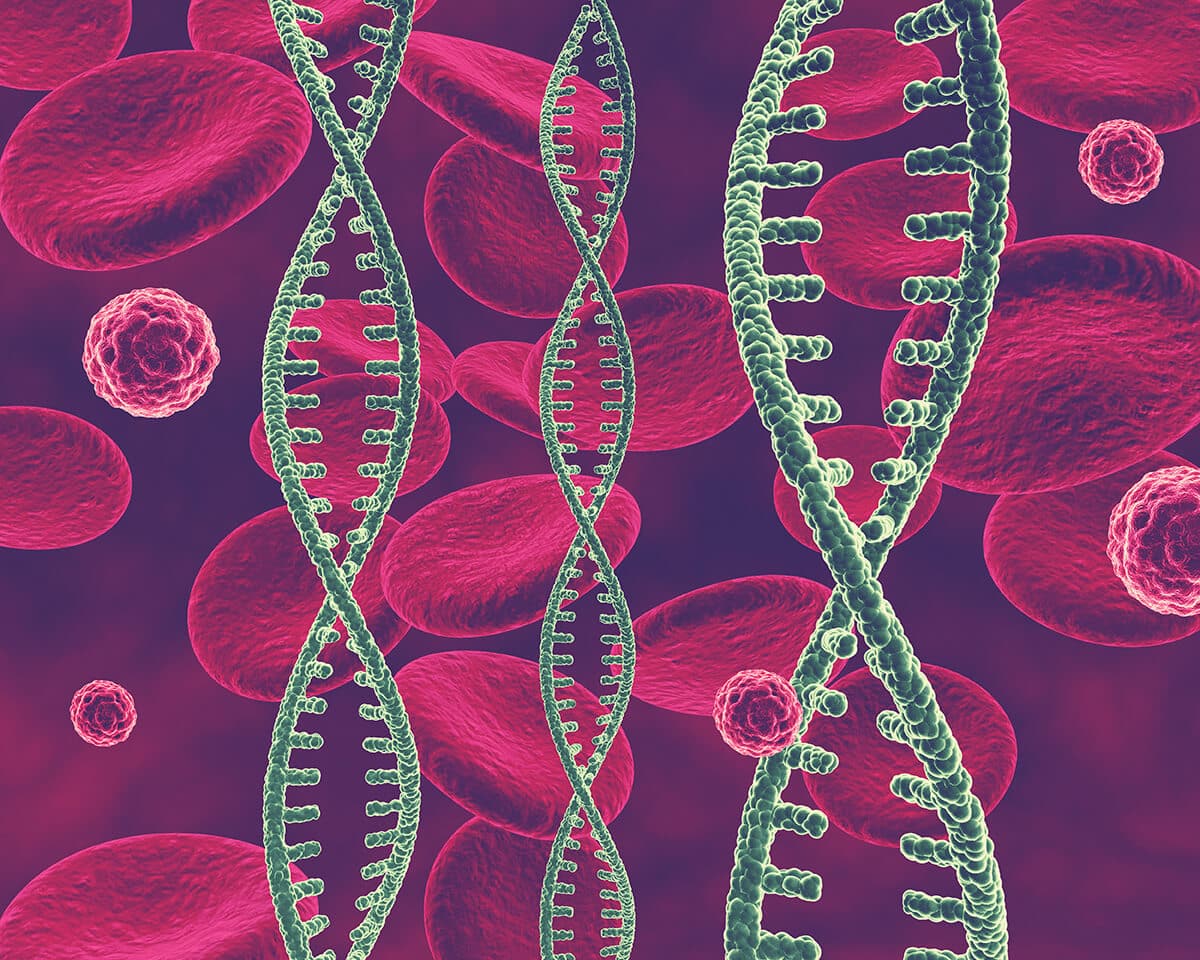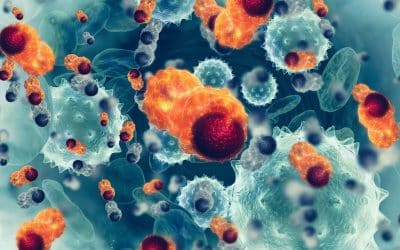Cell-free DNA and circulating tumor cells: which has more potential in precision oncology?
Many studies have demonstrated the advantages of technologies based on liquid biopsy in the genomic profiling of cancer patients. Blood-derived cell-free DNA (cfDNA)- and circulating tumor cell (CTC)-based methods are the two main diagnostic approaches. In our newest blog post, we compared them in terms of characteristics, origin, and clinical applications.
Circulating cell-free DNA (cfDNA)
Characteristics
CfDNA is a fragmented single- or double-stranded nucleic acid released from healthy or cancer cells. The amount of circulating tumor DNA (ctDNA) depends on the tumor size: it varies between 0,01% and 93% [1]. Their length is between 100 and 10000 bp.
The concentration of cfDNA in the blood of cancer patients was shown to range from 0 to 1000 ng/mL, with an average of 180 ng/mL. In contrast, its concentration in healthy people ranges from 0 to 100 ng/mL, with a 30 ng/mL average [2]. Elevated levels of cfDNA can be caused – apart from cancer – by various pathological conditions, such as acute and chronic inflammatory diseases, trauma, and cardiovascular diseases. However, certain non-malignant conditions may also contribute to increased cfDNA levels, for example, intense exercise, surgery, radiotherapy, and pregnancy [3,4].
The release of DNA from cells into circulation or other bodily fluids can happen through different mechanisms, such as apoptosis, necrosis, and active cellular secretion [5]. Currently, the most popular theory is that cfDNA originates from apoptotic and necrotic tumor cells in cancer patients, but it can be produced by bone marrow and white blood cells via normal physiological processes as well [6]. The diverse mechanisms result in DNA fragments of various sizes. Apoptosis leads to the breakage of chromosomal DNA into multiples of 160-180 bp fragments, and, as a result, most of the DNA present in plasma is 180-360 bp long. Due to necrosis, DNA fragments larger than 10000 bps are released and via active cellular release, the shedding DNA has 1000-3000 bp lengths [6].
While the tumors become increasingly aggressive, the level of necrosis rises along with cfDNA levels. The half-life of cfDNA in circulation is relatively short, estimated to be 16 minutes to 2,5 hours, providing a possibility for the real-time analysis of molecular signatures due to rapid turnover. The cfDNA fragments are degraded by nucleases in the blood, then eliminated through the liver, spleen, and kidneys [7–9].
Clinical application of cfDNAs
The differentiation of cfDNA by their origin is essential because white blood cell lysis can also contribute to increased cfDNA concentration. For this reason, cfDNA quantification cannot be an independent diagnostic marker and a direct indicator of tumor burden. Nevertheless, cfDNA originating from cancerous lesions can be differentiated through qualitative changes, also called cancer-specific alterations, which are unique somatic genetic modifications identical to those of the tumors themselves. In circulating cfDNA, these can be specific mutations, DNA methylation signatures, chromosomal instability markers, translocations, copy number alterations (CNAs), and loss of heterozygosity (LOH) [2,7,10,11]. Moreover, through the molecular characterization of cfDNA, both intratumor heterogeneity and spatially separated disease foci can be detected [12].
Acquired resistance to cancer therapies reflects tumor heterogeneity and the ability of cancer cells to adapt to therapy-induced selection pressures [9]. Through cfDNA analysis, the therapy response can be monitored as well, which allows for the adjustment of alternative or combinatorial treatments before clinical resistance occurs [13].
In some cases, after curative surgery, the tumor will relapse due to the presence of minimal residual disease (MRD), therefore, it is important to find a suitable marker for the detection of the residual tumor cells. The identification of cfDNA released from tumors, or CTCs after surgery might prove the presence of MR [14].
Circulating tumor cells (CTCs)
Characteristics
CTCs are malignant cells shedding from the primary solid tumor and/or metastatic tumor sites to the bloodstream, passively by detaching from tumor tissue or through the epithelial-mesenchymal transition (EMT) process [12,15,16]. CTCs possess tumor-specific characteristics and carry the potential to form distant metastases [2], after escaping anoikis [7,17]. Due to the harsh environment of the circulation created by the host immune system and physical forces, only an extremely small proportion of CTCs can survive [18] and cause metastases [19]. These metastasis-initiating CTCs have specific features, such as stemness, hybrid EMT state, immune surveillance escape, and drug resistance [19].
CTCs are extremely rare events compared to the number of hematopoietic cells in the circulation (1 per 106–107 leukocytes), and their half-life in the bloodstream is also short, approximately 1 to 2,4 hours [20]. The isolated CTCs remain viable for approximately 4 hours after sampling [7].
2-5% of all CTCs form clusters or circulating tumor microemboli. Regardless of their low number, they have a hundred times greater ability to give rise to metastasis [21] due to the interactions of distinct cell phenotypes, the strong cell-cell contacts, and the physical shelter against immune cell attacks [22]. CTC clusters are more than just assemblies of tumor cells: they consist of other non-malignant cells, such as endothelial cells, erythrocytes, stromal cells, leukocytes, platelets, and cancer-associated fibroblasts [22,23]. Through cluster forming, the survival rate of CTCs increases because the created microenvironment protects them from death in the circulation [23,24].
Cancer-associated thrombosis is one of the causes of death among cancer patients. When tumor cells enter the circulation, they first attach to platelets that enhance their survival and extravasation into new metastatic sites. The coagulation cascade is activated due to tumor cell and platelet aggregation. Furthermore, CTCs are protected by platelets against immune surveillance through their masking from natural killer cells [19].
Clinical application of CTCs
CTC numbers are an early prognostic marker of disease outcome, as they indicate cancer progression and provide information about the therapeutic response. However, CTC counts vary between tumor types and results also depend on the method used, even in the same patient cohort.
It was demonstrated that next-generation analysis provides more information than simply capturing and counting the CTCs [25]. CTCs represent a heterogeneous population of cells from different tumor foci with various molecular, phenotypic, and functional features [12,26]. Moreover, the molecular features of CTCs can change over the course of the disease or can be present in two different subpopulations with an alternative response to therapy [12].
Next to genetic heterogeneity, genomic instability is also a common feature of CTCs. By analyzing chromosomal instability (CIN) in CTCs and by tracking the genetic alterations that lead to tumor development, heterogeneous subpopulations can be detected. CIN refers to a high rate of change in the structure and/or the number of chromosomes (duplication, deletion, and translocation) over time [27].
Altogether, CTCs have a high predictive and prognostic value because they provide valuable insights that can be used for cancer diagnosis, disease progression monitoring, therapy response prediction, and targeted treatment selection [27].
One of the main advantages of CTCs, compared to cfDNA, is that they can be living cells, and if their cellular integrity is preserved after being captured, CTCs can be cultured for drug resistance evaluation [26].
Conclusion
From the available literature, it can be concluded that the analysis of cfDNA or CTC alone misses certain genetic features of tumors, therefore the combinatory analysis of these markers may provide complementary genetic information about cancer. Additionally, combined analysis of cfDNA and CTC offers richer information on tumor heterogeneity, which can be useful for guiding clinical strategies and targeted therapies [28].
Overall, the analysis of cfDNA is often chosen for the detection of mutations, CNAs, and DNA methylation changes, whereas CTC analysis provides the unique opportunity to study whole cells, thus allowing DNA, RNA, and protein-based molecular profiling, as well as in vivo studies [29]. Ideally, combined solutions with the strengths of CTC and cfDNA approaches should be developed to maximize the potential of liquid biopsy technologies.
Circulating tumor cell
Definition
Origin
Half-life
Extraction
Analysis
Advantages
Multiple test options
Live cells can be used in vitro/ in vivo
Disadvantages
Present in small amounts
Difficult to store
Cell-free DNA
Definition
Origin
Half-life
Extraction
Analysis
Advantages
Can be stored for a long time
Several clinically validated tests are available
Disadvantages
Variable levels (e.g. inflammation, sports, pregnancy)
Limited testing options
References
[1] Zhu JW, Charkhchi P, Akbari MR. Potential clinical utility of liquid biopsies in ovarian cancer. Mol Cancer 2022;21. https://doi.org/10.1186/S12943-022-01588-8.
[2] Cheng X, Zhang L, Chen Y, Qing C. Circulating cell-free DNA and circulating tumor cells, the “liquid biopsies” in ovarian cancer. J Ovarian Res 2017;10. https://doi.org/10.1186/S13048-017-0369-5.
[3] Tóth K, Patai Á v., Kalmár A, Barták BK, Nagy ZB, Galamb O, et al. Circadian Rhythm of Methylated Septin 9, Cell-Free DNA Amount and Tumor Markers in Colorectal Cancer Patients. Pathol Oncol Res 2017;23:699–706. https://doi.org/10.1007/S12253-016-0174-2.
[4] Madsen AT, Hojbjerg JA, Sorensen BS, Winther-Larsen A. Day-to-day and within-day biological variation of cell-free DNA. EBioMedicine 2019;49:284–90. https://doi.org/10.1016/J.EBIOM.2019.10.008.
[5] Elzanowska J, Semira C, Costa-Silva B. DNA in extracellular vesicles: biological and clinical aspects. Mol Oncol 2021;15:1701. https://doi.org/10.1002/1878-0261.12777.
[6] Feeney L, Harley IJ, McCluggage WG, Mullan PB, Beirne JP. Liquid biopsy in ovarian cancer: Catching the silent killer before it strikes. World J Clin Oncol 2020;11:868. https://doi.org/10.5306/WJCO.V11.I11.868.
[7] Sassu CM, Palaia I, Boccia SM, Caruso G, Perniola G, Tomao F, et al. Role of Circulating Biomarkers in Platinum-Resistant Ovarian Cancer. Int J Mol Sci 2021;22. https://doi.org/10.3390/IJMS222413650.
[8] Edwards RL, Menteer J, Lestz RM, Baxter-Lowe LA. Cell-free DNA as a solid-organ transplant biomarker: technologies and approaches. Biomark Med 2022;16:401–15. https://doi.org/10.2217/BMM-2021-0968.
[9] Oellerich M, Schütz E, Beck J, Kanzow P, Plowman PN, Weiss GJ, et al. Using circulating cell-free DNA to monitor personalized cancer therapy. Crit Rev Clin Lab Sci 2017;54:205–18. https://doi.org/10.1080/10408363.2017.1299683.
[10] Žilovič D, Čiurlienė R, Sabaliauskaitė R, Jarmalaitė S. Future Screening Prospects for Ovarian Cancer. Cancers 2021, Vol 13, Page 3840 2021;13:3840. https://doi.org/10.3390/CANCERS13153840.
[11] Govindarajan M, Wohlmuth C, Waas M, Bernardini MQ, Kislinger T. High-throughput approaches for precision medicine in high-grade serous ovarian cancer. J Hematol Oncol 2020;13:134. https://doi.org/10.1186/S13045-020-00971-6.
[12] Fici P. Cell-Free DNA in the Liquid Biopsy Context: Role and Differences Between ctDNA and CTC Marker in Cancer Management. Methods Mol Biol 2019;1909:47–73. https://doi.org/10.1007/978-1-4939-8973-7_4.
[13] Diaz LA, Bardelli A. Liquid biopsies: genotyping circulating tumor DNA. J Clin Oncol 2014;32:579–86. https://doi.org/10.1200/JCO.2012.45.2011.
[14] Yamada T, Matsuda A, Koizumi M, Shinji S, Takahashi G, Iwai T, et al. Liquid Biopsy for the Management of Patients with Colorectal Cancer. Digestion 2019;99:39–45. https://doi.org/10.1159/000494411.
[15] Bhardwaj BK, Thankachan S, Venkatesh T, Suresh PS. Liquid biopsy in ovarian cancer. Clinica Chimica Acta 2020;510:28–34. https://doi.org/10.1016/J.CCA.2020.06.047.
[16] Kim H, Lim M, Kim JY, Shin SJ, Cho YK, Cho CH. Circulating Tumor Cells Enumerated by a Centrifugal Microfluidic Device as a Predictive Marker for Monitoring Ovarian Cancer Treatment: A Pilot Study. Diagnostics (Basel) 2020;10. https://doi.org/10.3390/DIAGNOSTICS10040249.
[17] Lemma S, Perrone AM, Iaco P de, Gasparre G, Kurelac I. Current methodologies to detect circulating tumor cells: a focus on ovarian cancer. Am J Cancer Res 2021;11:4111.
[18] Mader S, Pantel K. Liquid Biopsy: Current Status and Future Perspectives. Oncol Res Treat 2017;40:404–8. https://doi.org/10.1159/000478018.
[19] Menyailo ME, Bokova UA, Ivanyuk EE, Khozyainova AA, Denisov E v. Metastasis Prevention: Focus on Metastatic Circulating Tumor Cells. Mol Diagn Ther 2021;25:549–62. https://doi.org/10.1007/S40291-021-00543-5.
[20] Yu Z, Song M, Chouchane L, Ma X. Functional Genomic Analysis of Breast Cancer Metastasis: Implications for Diagnosis and Therapy. Cancers (Basel) 2021;13. https://doi.org/10.3390/CANCERS13133276.
[21] Boya M, Ozkaya-Ahmadov T, Swain BE, Chu C-H, Asmare N, Civelekoglu O, et al. High throughput, label-free isolation of circulating tumor cell clusters in meshed microwells. Nat Commun 2022;13:3385. https://doi.org/10.1038/S41467-022-31009-9.
[22] Rostami P, Kashaninejad N, Moshksayan K, Saidi MS, Firoozabadi B, Nguyen NT. Novel approaches in cancer management with circulating tumor cell clusters. Journal of Science: Advanced Materials and Devices 2019;4:1–18. https://doi.org/10.1016/J.JSAMD.2019.01.006.
[23] Fabisiewicz A, Grzybowska E. CTC clusters in cancer progression and metastasis. Med Oncol 2017;34. https://doi.org/10.1007/S12032-016-0875-0.
[24] Asante DB, Calapre L, Ziman M, Meniawy TM, Gray ES. Liquid biopsy in ovarian cancer using circulating tumor DNA and cells: Ready for prime time? Cancer Lett 2020;468:59–71. https://doi.org/10.1016/J.CANLET.2019.10.014.
[25] Green BJ, Saberi Safaei T, Mepham A, Labib M, Mohamadi RM, Kelley SO. Beyond the Capture of Circulating Tumor Cells: Next-Generation Devices and Materials. Angew Chem Int Ed Engl 2016;55:1252–65. https://doi.org/10.1002/ANIE.201505100.
[26] Ahn JC, Teng PC, Chen PJ, Posadas E, Tseng HR, Lu SC, et al. Detection of Circulating Tumor Cells and Their Implications as a Biomarker for Diagnosis, Prognostication, and Therapeutic Monitoring in Hepatocellular Carcinoma. Hepatology 2021;73:422–36. https://doi.org/10.1002/HEP.31165.
[27] Freitas MO, Gartner J, Rangel-Pozzo A, Mai S. Genomic Instability in Circulating Tumor Cells. Cancers (Basel) 2020;12:1–22. https://doi.org/10.3390/CANCERS12103001.
[28] Lee SY, Chae DK, An J, Yoo S, Jung S, Chae CH, et al. Combinatory Analysis of Cell-free and Circulating Tumor Cell DNAs Provides More Variants for Cancer Treatment. Anticancer Res 2019;39:6595–602. https://doi.org/10.21873/ANTICANRES.13875.
[29] Calabuig-Fariñas S, Jantus-Lewintre E, Herreros-Pomares A, Camps C. Circulating tumor cells versus circulating tumor DNA in lung cancer—which one will win? Transl Lung Cancer Res 2016;5:466–82. https://doi.org/10.21037/TLCR.2016.10.02.
Recent blogs
A New Era in Liver Cancer Detection: The Promise of HepaAiQ
In this blog entry, we will explore the recent history, intriguing findings, and tools related to cfDNA fragmentomics.
Cell-free DNA Fragmentomics: A Promising Predictor of Cancer
In this blog entry, we will explore the recent history, intriguing findings, and tools related to cfDNA fragmentomics.
New developments in the field of circulating tumor cells (2024)
The blog post focuses on how researchers can produce more meaningful, applicable results that directly benefit human health.




